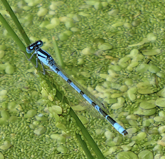By Bob Suchanek
“Summer: I go down to the creek again, and lead a creek life. I watch and stalk.”
-Annie Dillard
Odonata - The Toothed Ones
Summertime and the toothed ones are about — aerial monsters eating as much as they weigh every week and dominating as the top predators of their insect world.
No special tools or skills are required to stalk these beasts. Just look for them cruising above and around creeks, lake shores, or wetlands and take a seat. If you sit quietly they will come and the watching may begin.
The Odonata demonstrate spectacular aerial mastery. They can fly forward at as much as 100 body lengths per second (comparable to a 33-foot-long jet flying at 3 times the speed of sound) and backwards at a few body lengths per second. They can also hover in one place for up to a minute.
The point of these impressive aeronautics is lunch. A toothy apparatus on their wings is a sophisticated modified jaw that folds neatly and aerodynamically. When a juicy mosquito or mayfly is in sight, the jaw is deployed to snatch and pull back its hapless meal for munching and ingestion.
Damselflies and Dragonflies
There are two Odonata subgroups in Minnesota: dragonflies and damselflies, and about 140 different species. These groups and their relatives have been insect terrors since dinosaurs roamed the earth. In the Mesozoic, some extinct related species had wingspans of over two feet.
The largest modern dragonflies have wingspans of around 8 inches. In Minnesota, maximum wingspans are a modest three or four inches. Damselflies tend to be slender while dragonflies have thicker bodies. Dragonflies rest with their wings held horizontally while damselflies fold their wings close to their bodies.

Damselfly
Photo by Bob Suchanek

Dragonfly
Photo by Bob Suchanek
Darning Needles
My grandmother called dragonflies and damselflies “darning needles”. This was an enduring mystery only recently resolved for me.
Dragonflies and damselflies lay their eggs just under the surface of the waters they live by. Sooner or later an Odonata stalker will see this behavior—a female flying low over the surface of quiet water and repeatedly dipping the ovipositor at the end of her abdomen.
According to Annie Dillard “It is this peculiar stitching motion of the dragonfly’s abdomen that earned it the name ‘darning needle’. Parents used to threaten their children by saying that, if the children told lies, dragonflies would hover over their faces as they slept and sew their lips together.” My grandmother spared me those details.
Some Odonata Stalking Inspiration and Information
Dillard, Annie. Pilgrim at Tinker Creek. New York, NY: HarperCollins. ISBN 0-06-095302-0.
https://www.inaturalist.org/check_lists/165010-Odonata-of-Minnesota
https://www.lakesuperiorstreams.org/understanding/bugs_odonata.html
https://en.wikipedia.org/wiki/Odonata